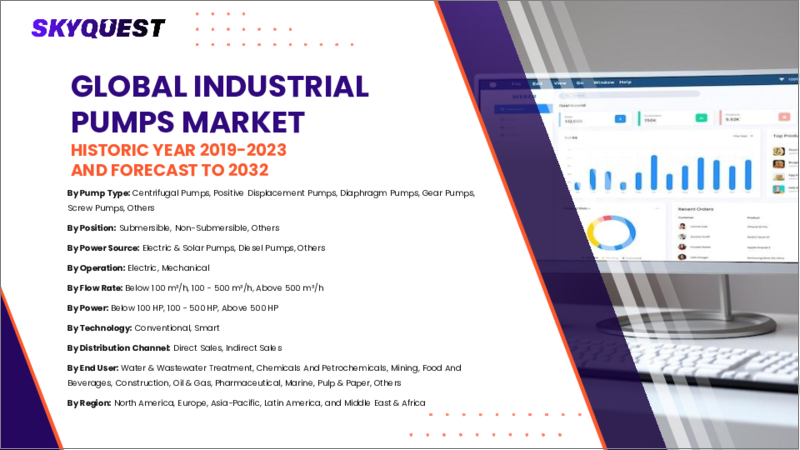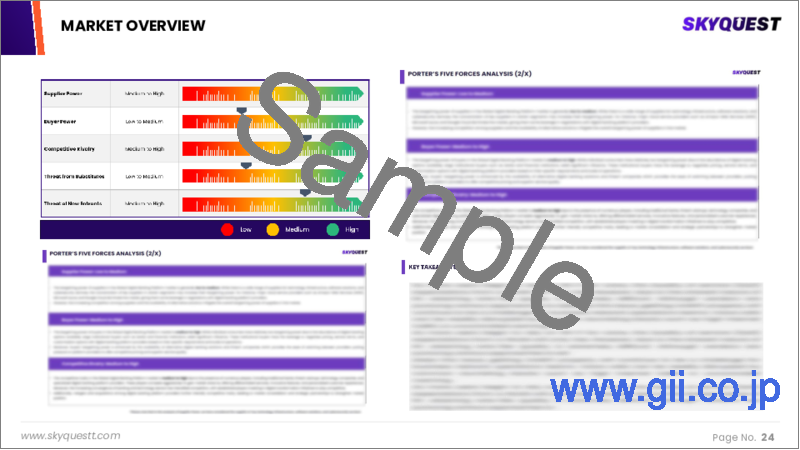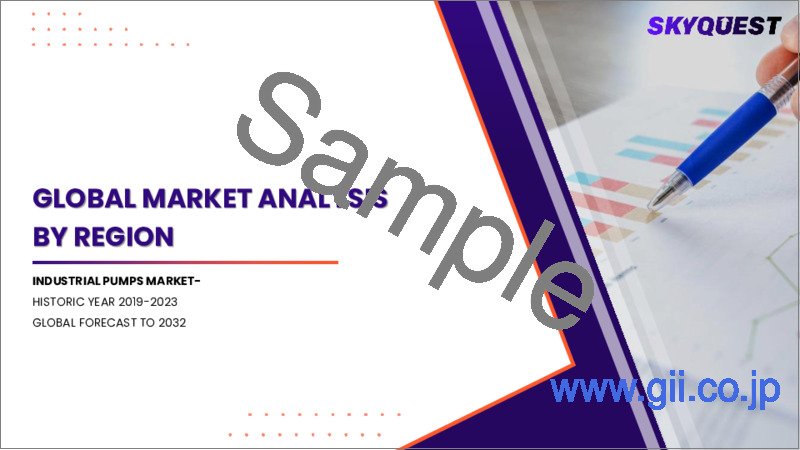|
|
市場調査レポート
商品コード
1701007
産業用ポンプの市場規模、シェア、成長分析:ポンプタイプ別、動力源別、流量別、動力別、技術別、流通チャネル別、エンドユーザー別、地域別 - 産業予測、2025年~2032年Industrial Pumps Market Size, Share, and Growth Analysis, By Pump Type, By Power Source, By Flow Rate, By Power, By Technology, By Distribution Channel, By End Users, By Region - Industry Forecast 2025-2032 |
||||||
|
|||||||
| 産業用ポンプの市場規模、シェア、成長分析:ポンプタイプ別、動力源別、流量別、動力別、技術別、流通チャネル別、エンドユーザー別、地域別 - 産業予測、2025年~2032年 |
|
出版日: 2025年04月02日
発行: SkyQuest
ページ情報: 英文 202 Pages
納期: 3~5営業日
|
全表示
- 概要
- 目次
産業用ポンプの世界市場規模は2023年に441億米ドルと評価され、予測期間(2025年~2032年)のCAGRは5.1%で、2024年の463億5,000万米ドルから2032年までには690億米ドルに成長する見通しです。
世界の産業用ポンプ市場は、様々な産業に不可欠な信頼性が高く効率的なポンプソリューションに対する需要の増加により、顕著な成長を遂げています。これらのポンプは、生産・流通プロセス全体を通じて流体やガスの移送に必要な最適な流量と圧力を確保する上で重要な役割を果たしており、生産性の維持とエネルギー消費の最小化に不可欠です。都市化の進展、インフラ開発、効果的な水・廃水管理の差し迫った必要性などの要因が、この分野の需要を促進しています。さらに、石油・ガス産業の拡大は、ポンプメーカーにさらなるチャンスをもたらしています。しかし、初期コストの高さ、メンテナンスの複雑さ、原材料価格の変動といった課題は依然として残っています。スマートポンプシステムのような技術革新や、環境に優しいソリューションへの注力により、この市場は持続的な成長を遂げ、特に米国市場では今後数年間で安定したCAGRが見込まれます。
目次
イントロダクション
- 調査の目的
- 調査範囲
- 定義
調査手法
- 情報調達
- 二次と一次データの方法
- 市場規模予測
- 市場の前提条件と制限
エグゼクティブサマリー
- 世界市場の見通し
- 供給と需要の動向分析
- セグメント別機会分析
市場力学と見通し
- 市場概要
- 市場規模
- 市場力学
- 促進要因と機会
- 抑制要因と課題
- ポーターの分析
主要な市場の考察
- 主要成功要因
- 競合の程度
- 主要な投資機会
- 市場エコシステム
- 市場の魅力指数(2024年)
- PESTEL分析
- マクロ経済指標
- バリューチェーン分析
- 価格分析
- 規制情勢
- ケーススタディ
- 技術分析
世界の産業用ポンプの市場規模:ポンプタイプ別・CAGR(2025年~2032年)
- 市場概要
- 遠心ポンプ
- 軸流ポンプ
- ラジアルフローポンプ
- 斜流ポンプ
- 容積式ポンプ
- 往復ポンプ
- ロータリーポンプ
- その他
- ダイヤフラムポンプ
- ギアポンプ
- スクリューポンプ
- その他
世界の産業用ポンプの市場規模:動力源別・CAGR(2025年~2032年)
- 市場概要
- 電動ポンプ・ソーラーポンプ
- ディーゼルポンプ
- その他
世界の産業用ポンプの市場規模:流量別・CAGR(2025年~2032年)
- 市場概要
- 100 m3/h以下
- 100~500 m3/h
- 500 m3/h以上
世界の産業用ポンプの市場規模:動力別・CAGR(2025年~2032年)
- 市場概要
- 100HP以下
- 100~500HP
- 500HP以上
世界の産業用ポンプの市場規模:技術別・CAGR(2025年~2032年)
- 市場概要
- 従来型
- スマート
世界の産業用ポンプの市場規模:流通チャネル別・CAGR(2025年~2032年)
- 市場概要
- 直接販売
- 間接販売
世界の産業用ポンプの市場規模:エンドユーザー別・CAGR(2025年~2032年)
- 市場概要
- 水・廃水処理
- 化学製品・石油化学製品
- 鉱業
- 食品・飲料
- 建設
- 石油・ガス
- 医薬品
- 海洋
- パルプ・紙
- その他
世界の産業用ポンプの市場規模・CAGR(2025年~2032年)
- 北米
- 米国
- カナダ
- 欧州
- ドイツ
- スペイン
- フランス
- 英国
- イタリア
- その他欧州地域
- アジア太平洋
- 中国
- インド
- 日本
- 韓国
- その他アジア太平洋
- ラテンアメリカ
- ブラジル
- その他ラテンアメリカ地域
- 中東・アフリカ
- GCC諸国
- 南アフリカ
- その他中東・アフリカ
競合情報
- 上位5社の比較
- 主要企業の市場ポジショニング(2024年)
- 主な市場企業が採用した戦略
- 最近の市場動向
- 企業の市場シェア分析(2024年)
- 主要企業の企業プロファイル
- 企業の詳細
- 製品ポートフォリオ分析
- 企業のセグメント別シェア分析
- 収益の前年比比較(2022年~2024年)
主要企業プロファイル
- Flowserve Corporation(United States)
- Grundfos Holding A/S(Denmark)
- KSB SE & Co. KGaA(Germany)
- Sulzer Ltd.(Switzerland)
- EBARA Corporation(Japan)
- Xylem Inc.(United States)
- Weir Group PLC(United Kingdom)
- Schlumberger Limited(United States)
- Baker Hughes Company(United States)
- Pentair plc(United States)
- WILO SE(Germany)
- ITT Inc.(United States)
- Dover Corporation(United States)
- SPX Flow Inc.(United States)
- Danfoss AS(Denmark)
- Dresser LLC(United States)
- Ruhrpumpen Group(Mexico)
- Clyde Union Inc.(United Kingdom)
- SPP Pumps Inc.(United States)
- Dover Engineered Products Segment Inc.(United States)
結論と提言
Global Industrial Pumps Market size was valued at USD 44.1 billion in 2023 and is poised to grow from USD 46.35 billion in 2024 to USD 69.0 billion by 2032, growing at a CAGR of 5.1% during the forecast period (2025-2032).
The global industrial pumps market has experienced notable growth due to an increasing demand for reliable and efficient pumping solutions essential for various industries. These pumps play a critical role in ensuring optimal flow rates and pressures necessary for fluid and gas transfer throughout production and distribution processes, which are vital for maintaining productivity and minimizing energy consumption. Factors such as rising urbanization, infrastructure development, and the pressing need for effective water and wastewater management are propelling demand in the sector. Additionally, the oil and gas industry's expansion opens further opportunities for pump manufacturers. However, challenges like high initial costs, maintenance complexities, and fluctuating raw material prices persist. With innovations like smart pump systems and a focus on environmentally friendly solutions, this market is set for sustainable growth, especially in the U.S. market, which is projected to see a steady CAGR in the coming years.
Top-down and bottom-up approaches were used to estimate and validate the size of the Global Industrial Pumps market and to estimate the size of various other dependent submarkets. The research methodology used to estimate the market size includes the following details: The key players in the market were identified through secondary research, and their market shares in the respective regions were determined through primary and secondary research. This entire procedure includes the study of the annual and financial reports of the top market players and extensive interviews for key insights from industry leaders such as CEOs, VPs, directors, and marketing executives. All percentage shares split, and breakdowns were determined using secondary sources and verified through Primary sources. All possible parameters that affect the markets covered in this research study have been accounted for, viewed in extensive detail, verified through primary research, and analyzed to get the final quantitative and qualitative data.
Global Industrial Pumps Market Segments Analysis
Global Industrial Pumps Market is segmented by Pump Type, Power Source, Flow Rate, Power, Technology, Distribution Channel, End Users and region. Based on Pump Type, the market is segmented into Centrifugal pumps, Positive displacement pumps, Diaphragm pumps, Gear pumps, Screw pumps and Others. Based on Power Source, the market is segmented into Electric & solar pumps, Diesel pumps and Others. Based on Flow Rate, the market is segmented into Below 100 m3/h, 100 - 500 m3/h and Above 500 m3/h. Based on Power, the market is segmented into Below 100 HP, 100 - 500 HP and Above 500 HP. Based on Technology, the market is segmented into Conventional and Smart. Based on Distribution Channel, the market is segmented into Direct sales and Indirect sales. Based on End Users, the market is segmented into Water & wastewater treatment, Chemicals and petrochemicals, Mining, Food and beverages, Construction, Oil & gas, Pharmaceutical, Marine, Pulp & paper and Others. Based on region, the market is segmented into North America, Europe, Asia Pacific, Latin America and Middle East & Africa.
Driver of the Global Industrial Pumps Market
The global demand for industrial pumps is significantly propelled by ongoing infrastructure development projects, especially in emerging economies. These initiatives encompass the construction of essential facilities such as roads, bridges, airports, and buildings, all of which necessitate efficient water supply, sewage management, and heating, ventilation, and air conditioning (HVAC) systems. A prime example is China's "Belt and Road Initiative," which involves extensive infrastructure projects in numerous countries, thereby generating a robust need for industrial pumps to facilitate water management and support various construction efforts. This rising demand underscores the critical role of industrial pumps in modern infrastructure expansion.
Restraints in the Global Industrial Pumps Market
The Global Industrial Pumps market faces notable constraints due to the substantial initial capital investment needed for procurement, particularly for large-scale endeavors. Furthermore, the operational and maintenance complexities associated with these pumps can create significant challenges for users. For instance, in sectors like oil and gas, establishing and maintaining high-pressure pumps on offshore platforms demand considerable financial resources and specialized technical knowledge. This complexity and cost barrier can hinder widespread adoption, as companies must weigh the benefits against the significant expenditures and expertise required to manage such sophisticated equipment effectively.
Market Trends of the Global Industrial Pumps Market
The Global Industrial Pumps market is increasingly shifting towards the adoption of smart pump systems that leverage advanced technologies like IoT sensors, automation, and data analytics. This trend facilitates real-time monitoring and remote control capabilities, enabling predictive maintenance that significantly enhances operational efficiency. By detecting anomalies early, these smart systems minimize downtime and energy consumption, aligning with the industry's push for sustainability and cost reductions. As manufacturers and end-users alike prioritize innovation, the integration of smart technology into industrial pumps is set to drive substantial growth, meet evolving operational demands, and lead to more intelligent fluid management solutions globally.
Table of Contents
Introduction
- Objectives of the Study
- Scope of the Report
- Definitions
Research Methodology
- Information Procurement
- Secondary & Primary Data Methods
- Market Size Estimation
- Market Assumptions & Limitations
Executive Summary
- Global Market Outlook
- Supply & Demand Trend Analysis
- Segmental Opportunity Analysis
Market Dynamics & Outlook
- Market Overview
- Market Size
- Market Dynamics
- Drivers & Opportunities
- Restraints & Challenges
- Porters Analysis
- Competitive rivalry
- Threat of substitute
- Bargaining power of buyers
- Threat of new entrants
- Bargaining power of suppliers
Key Market Insights
- Key Success Factors
- Degree of Competition
- Top Investment Pockets
- Market Ecosystem
- Market Attractiveness Index, 2024
- PESTEL Analysis
- Macro-Economic Indicators
- Value Chain Analysis
- Pricing Analysis
- Regulatory Landscape
- Case Studies
- Technology Analysis
Global Industrial Pumps Market Size by Pump Type & CAGR (2025-2032)
- Market Overview
- Centrifugal pumps
- Axial Flow Pump
- Radial Flow Pump
- Mixed Flow Pump
- Positive displacement pumps
- Reciprocating Pumps
- Rotary Pumps
- Others
- Diaphragm pumps
- Gear pumps
- Screw pumps
- Others
Global Industrial Pumps Market Size by Power Source & CAGR (2025-2032)
- Market Overview
- Electric & solar pumps
- Diesel pumps
- Others
Global Industrial Pumps Market Size by Flow Rate & CAGR (2025-2032)
- Market Overview
- Below 100 m3/h
- 100 - 500 m3/h
- Above 500 m3/h
Global Industrial Pumps Market Size by Power & CAGR (2025-2032)
- Market Overview
- Below 100 HP
- 100 - 500 HP
- Above 500 HP
Global Industrial Pumps Market Size by Technology & CAGR (2025-2032)
- Market Overview
- Conventional
- Smart
Global Industrial Pumps Market Size by Distribution Channel & CAGR (2025-2032)
- Market Overview
- Direct sales
- Indirect sales
Global Industrial Pumps Market Size by End Users & CAGR (2025-2032)
- Market Overview
- Water & wastewater treatment
- Chemicals and petrochemicals
- Mining
- Food and beverages
- Construction
- Oil & gas
- Pharmaceutical
- Marine
- Pulp & paper
- Others
Global Industrial Pumps Market Size & CAGR (2025-2032)
- North America (Pump Type, Power Source, Flow Rate, Power, Technology, Distribution Channel, End Users)
- US
- Canada
- Europe (Pump Type, Power Source, Flow Rate, Power, Technology, Distribution Channel, End Users)
- Germany
- Spain
- France
- UK
- Italy
- Rest of Europe
- Asia Pacific (Pump Type, Power Source, Flow Rate, Power, Technology, Distribution Channel, End Users)
- China
- India
- Japan
- South Korea
- Rest of Asia-Pacific
- Latin America (Pump Type, Power Source, Flow Rate, Power, Technology, Distribution Channel, End Users)
- Brazil
- Rest of Latin America
- Middle East & Africa (Pump Type, Power Source, Flow Rate, Power, Technology, Distribution Channel, End Users)
- GCC Countries
- South Africa
- Rest of Middle East & Africa
Competitive Intelligence
- Top 5 Player Comparison
- Market Positioning of Key Players, 2024
- Strategies Adopted by Key Market Players
- Recent Developments in the Market
- Company Market Share Analysis, 2024
- Company Profiles of All Key Players
- Company Details
- Product Portfolio Analysis
- Company's Segmental Share Analysis
- Revenue Y-O-Y Comparison (2022-2024)
Key Company Profiles
- Flowserve Corporation (United States)
- Company Overview
- Business Segment Overview
- Financial Updates
- Key Developments
- Grundfos Holding A/S (Denmark)
- Company Overview
- Business Segment Overview
- Financial Updates
- Key Developments
- KSB SE & Co. KGaA (Germany)
- Company Overview
- Business Segment Overview
- Financial Updates
- Key Developments
- Sulzer Ltd. (Switzerland)
- Company Overview
- Business Segment Overview
- Financial Updates
- Key Developments
- EBARA Corporation (Japan)
- Company Overview
- Business Segment Overview
- Financial Updates
- Key Developments
- Xylem Inc. (United States)
- Company Overview
- Business Segment Overview
- Financial Updates
- Key Developments
- Weir Group PLC (United Kingdom)
- Company Overview
- Business Segment Overview
- Financial Updates
- Key Developments
- Schlumberger Limited (United States)
- Company Overview
- Business Segment Overview
- Financial Updates
- Key Developments
- Baker Hughes Company (United States)
- Company Overview
- Business Segment Overview
- Financial Updates
- Key Developments
- Pentair plc (United States)
- Company Overview
- Business Segment Overview
- Financial Updates
- Key Developments
- WILO SE (Germany)
- Company Overview
- Business Segment Overview
- Financial Updates
- Key Developments
- ITT Inc. (United States)
- Company Overview
- Business Segment Overview
- Financial Updates
- Key Developments
- Dover Corporation (United States)
- Company Overview
- Business Segment Overview
- Financial Updates
- Key Developments
- SPX Flow Inc. (United States)
- Company Overview
- Business Segment Overview
- Financial Updates
- Key Developments
- Danfoss AS (Denmark)
- Company Overview
- Business Segment Overview
- Financial Updates
- Key Developments
- Dresser LLC (United States)
- Company Overview
- Business Segment Overview
- Financial Updates
- Key Developments
- Ruhrpumpen Group (Mexico)
- Company Overview
- Business Segment Overview
- Financial Updates
- Key Developments
- Clyde Union Inc. (United Kingdom)
- Company Overview
- Business Segment Overview
- Financial Updates
- Key Developments
- SPP Pumps Inc. (United States)
- Company Overview
- Business Segment Overview
- Financial Updates
- Key Developments
- Dover Engineered Products Segment Inc. (United States)
- Company Overview
- Business Segment Overview
- Financial Updates
- Key Developments






